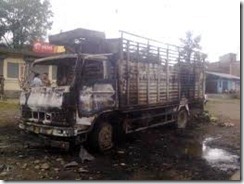Civilians in Kashmir and the Northeast want the 'draconian' AFSPA repealed, but the army says it can't operate without it. Avalok Langer reports on the dichotomy

Naked rage Manipuri women protest against the army's high-handedness
In the Rann of Kutch, the sighting of a military jonga brings kids on the road, waving, laughing, chasing the vehicle. Others salute the jeep as it passes. The same is likely to happen in Jammu.
But in Kashmir and most parts of the Northeast, young boys and girls take aim with imaginary guns, shooting as a convoy passes.

In the dock In Kashmir, the army can arrest anyone without a warrant
Photo: AP
It is the same army, the same soldiers, but the stark difference in their role creates the duality. Along the western border, the Indian Army stands guard against an external enemy. But in Kashmir and the Northeast, the army, performing a policing role, has fallen from grace.
A 'special' role requires 'special powers' and in 1958, the Armed Forces Special Powers Acts (AFSPA) was enacted to aid antiinsurgency operations. Currently, Jammu & Kashmir, Nagaland and parts of Manipur, Assam, Meghalaya, Tripura and Arunachal Pradesh are under AFSPA - a single-page law that allows shooting to kill on mere suspicion; arrest, search and detention without warrant; and protection from prosecution. These clauses, many feel, violate fundamental rights.
Responding to mounting public pressure, Union Home Minster P Chidambaram recently suggested that AFSPA may be amended. He said he is in talks with Omar Abdullah to rethink J&K's 'disturbed area' status, giving hope to those who have been campaigning against it. But a brigadier serving there says, "If AFSPA is removed from certain areas of the state, they will not only become safe havens for militants, but highways that pass through these areas will become soft targets."
But, why is the army deployed within our own borders when law and order is a state subject? The security mechanism dictates that each state government should have its own security machinery - the police, armed police and in some cases special groups like the Anti-Terrorism Squad to manage law and order. If they are unable to tackle a problem, Central forces such as the CRPF, RAF, ITBP and BSF are deployed under the operational control of the state. It is only when the Governor feels that the state's efforts have failed and armed forces are needed, the region is declared a 'disturbed area' and the army is brought in.
"The army is called in when a section of Indian territory is ungovernable and the situation may lead to secession," says a senior army officer. "Our Constitution does not allow for areas to declare themselves sovereign. It is considered a direct challenge to the State and the army's job is to facilitate the return to normalcy." He claims that insurgencies in areas where AFSPA is operational are not home-grown. "If you look at the area in which AFSPA has been applied, there is direct foreign support in term of training, arms and ideology. This complicates the issue further," he says.
However, Kashmiri lawyer Fasiha Qabri, 31, feels that the creation of 'disturbed areas' is arbitrary and forced upon a region. "The governor or the Central government, not the state government, have the power to declare a state or part of its area as disturbed," she says.
Inshah Malik, 26, a PhD student from Kashmir, says, "AFSPA, which is meant to be an emergency law, violates human rights. The law is vague and has no standards. Lethal force can be exercised if it is deemed necessary. Who decides if it is necessary? Life and death cannot be left subject to an individual's rationale."
An army officer agrees the Act provides impunity from a civil trial, but not from justice. "It may seem that there exists impunity as military personnel are not tried in civilian courts, but justice comes in the form of the Army Act, which comes under the statutes of the Constitution," he says. "The proof is the numerous court martials of personnel serving in CI-Ops (counterinsurgency operations) areas. Other countries that have suffered from insurgencies have created teams like the 'gendarmerie', a military force charged with police duties among civilian population. They have the backing of the Constitution and don't need laws like AFSPA. But we have opted to send the army, so we need such a law."
Armed with Special Powers
Security forces may enjoy legal sanction, but at a certain level AFSPA violates fundamental rights
AFSPA Section 4 (A)
Right to use force (shoot) after giving due warning, even resulting in death
Constitution Article 21
No person shall be deprived of his life
AFSPA Section 4 (C)
Arrest and detain without warrant
Constitution Article 22
Prevention against arbitrary arrest and detention, the accused has to be produced in front of a magistrate within 24 hours
AFSPA Section 6
Protection from legal proceedings for a person acting under law
Constitution Article 14
Equality before the law or equal protection of law
AFSPA has been in effect in these areas
Since 1958
Assam, Manipur
Since 1972
Arunachal Pradesh, Nagaland, Tripura, Mizoram and Meghalaya
Since 1990
Jammu & Kashmir
On the point of the law's 'vagueness', the officer says, "The law is not vague to us. Due warning is specified in the army's rule of patrolling. In an operational situation everything is detailed out - how many times to shout a warning before shooting, who will take on what role in a cordon-and-search situation, etc. The operational rules are set out for us, but there are thousands of us in active duty. Some may not adhere to the rule completely.''
HOWEVER, A grieving mother in Srinagar would not understand this. Parveena Ahanger has spent 21 years searching for her son Javed, 16, who was picked up by security forces on 18 August 1990. He seemed to disappear into thin air. Parveena has found no respite as the inquiry into her son's case awaits the sanction of the home ministry. "There are laws against militants who pick up guns but there are no laws against the army. They picked up my son in the middle of the night in front of the whole family, but now they don't have him. Where is he? Where are the hundreds of other sons, husbands and fathers that have disappeared?'' she asks. "There is no measure of a mother's pain, I have lost everything. They have offered me money, a government job, property, but all I want is my son. This law must go.''
Having taken part in CIOps, an officer gives an example of the grey areas in which they have to operate: "A foreign terrorist, an explosives expert, crossed into India with the help of a local shepherd. Food, women and supplies were brought to his hideout by an overground worker. The worker took him to his target spot, showed the routes and informed about the local security set-up. The worker, shepherd and the women were all aware of the terrorist's presence. Indirectly or directly, they are all involved in an illegal act. After the blast, we got a tip that on the night of the blast a group of 10 men threw a party in a village close to the blast site. We cordoned the house and arrested the men. Nine of them turned out to be innocent, but the 10th spilled the beans on the hideout. We work based on local intelligence in a time-sensitive environment. We need special powers to operate effectively.''
The implication is that operations cannot be held captive to administrative delays. If the local police cannot be trusted, search warrants are useless. Logistically it is not possible to have women officers at every post, argues the officer. "If at a national level a decision has been taken to declare a certain area as 'special', certain fundamental rights may be curtailed,'' he adds. "It is not a normal situation, but these are our operational realities.''
After conducting studies in J&K and Manipur, the Human Rights Watch believes AFSPA has resulted in a situation where it is easier for the security forces to kill a 'criminal' rather than collect evidence against him. "There is a generation of Nagas in Mokokchung who are so terrified of the armed forces that they wet themselves at the sight of a green uniform,'' reveals Akum Longchari, a researcher based in Dimapur, Nagaland.
'There is a generation of Nagas who are so terrified of the army that they wet themselves at the sight of a green uniform,' says Akum
Recounting the horrors of 'Operation Blue Bird' in 1987, the then 13-year-old Joyson Mazamo from Khondei Shimphung in Manipur says, "We were asked to gather in the church where we were kept from July to October. Turn by turn, the men were taken out to be 'questioned', but returned bruised, beaten and tortured. I remember my father returning with a broken arm, my uncle's dead body, charred beyond recognition. The soldiers felt they could do anything and get away with it.''
Interestingly, many feel that the army's attitude, AFSPA and the sense of impunity have played into the hands of the rebels. "It creates a sense of anger and alienation among the common man that aggravates the problem by creating potential recruits for the underground groups,'' explains Longchari. "It is a question of training. (The army) is trained to be aggressive, to deal with the enemy, but can you behave the same way with civilians?''
To this, officers argue that compared to South America, Africa or Chechnya, where tanks and helicopter gunships were used to deal with a challenge to their sovereignty, the Indian Army has kept force application to a minimum. "For this reason we continue to suffer heavy casualties,'' says an officer. "We are fighting with our hands tied behind our backs.''
Many senior officers feel that though a special law is needed, AFSPA can be modified. The question is: to what degree? In the case of Manipur, the prime minister had said that a more humane law will soon replace AFSPA. It is believed the law will relook the 'shoot to kill' and 'search without a warrant' clauses. To which, a senior army officer retorts, "Then remove the army and deal with the problem with police forces.''
After more than 50 years of operating in an environment where local politicians provide patronage to militants and the local police may or may not pass on information to them, army officers often admit that "the problem is political not military''. A senior officer argues, "We are not here by choice. We are here to perform a duty.''
But political indecision has lead to protracted military deployment, worsening the situation. This is one of the reasons why the army is averse to being deployed in the Naxal belt. This may be the crux of the solution. "Political issues need political solutions,'' says Longchari. "Only a strong India can negotiate and find peaceful solutions for many of its problems.''
Avalok Langer is a Correspondent with Tehelka. avalok@tehelka.com
 Imphal, Sep 27 : Laborers and workers who come to Manipur from other Indian states often find themselves at the mercy of insurgents. Recently, two workers from Bihar were killed.
Imphal, Sep 27 : Laborers and workers who come to Manipur from other Indian states often find themselves at the mercy of insurgents. Recently, two workers from Bihar were killed.















 Aizawl, Sep 25 : The state government has vigorously pursued the Central government s mission to make Aizawl a solar city, urban development and poverty alleviation minister Zodintluanga said today.
Aizawl, Sep 25 : The state government has vigorously pursued the Central government s mission to make Aizawl a solar city, urban development and poverty alleviation minister Zodintluanga said today. 



